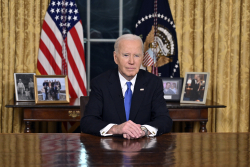While the Super Hornet has primarily been deployed for air-to-ground attack, it has also proven itself in air-to-air combat.
The American-made F/A-18 Super Hornet is arguably the pinnacle of the US military’s Red Sea strategy at the moment. Launched from the Navy’s aircraft carriers, these unmatched fighter jets are responsible for many of the interceptions of Houthi-launched projectiles amidst the ongoing conflict in the region. These 4.5-generation jets may not possess the stealth of their F-35 Lightning II and F-22 Raptor successors, but when it comes to ordnance power and its two-engine advantage, the Super Hornet remains a critical player in the skies. Earlier this week, the US State Department approved a potential $2 billion deal to sustain Australia’s current Super Hornet and EA-18G Growler electronic warfare fleets. Considering the performance record of these platforms and rising geopolitical tensions across the globe, the beefing up of the US ally’s aerial capabilities makes sense.
According to an announcement made by the Defense Security Cooperation Agency (DSCA), Australia is set to purchase 60 Global Lightning Transceivers and 24 Next-Generation Electronic Attack Units. “The proposed sale will improve Australia’s capability to meet current and future threats by providing the necessary follow-on sustainment support services for its F/A-18F Super Hornet and EA-18G Growler aircraft fleet,” the DSCA announcement says. This news comes just two months after Washington gave the green light for Canberra to procure 200 AIM-120C and AIM-120D air-to-air missiles.
Introducing the F/A-18 Super Hornet
The Navy’s most advanced frontline carrier-based strike fighter has surprisingly been in service for nearly a quarter-century. As a variant of the Boeing (formerly McDonnell Douglas F/A-18 Hornet, the Super Hornet features extensive top-tier capabilities. The impressive platform is larger, heavier, and more capable than its predecessor. The F/A-18E is the single-seat version of the Super Hornet, whilst the F/A-18F is the tandem seater. Since the Super Hornet’s first exposure to combat during the 2002 Operation Southern Watch strike on surface-to-air missiles in Iraq, the platform has proved itself as the cornerstone of the Navy’s aerial power time and time again.
While the Super Hornet has primarily been deployed for air-to-ground attack, it has also proven itself in air-to-air combat. In 2018, a US Navy F/A-18E downed a Syrian Air Force Sukhoi Su-22 “Fitter” fighter-bomber, which represented the first aerial kill of a crewed aircraft by an American jet since 1999 and the US Navy’s first since Operation Desert Storm. The newest iteration of the Super Hornet is the Block III. These impressive jets boast longer lifespans, greater stealth, improved survivability, and enhanced networking and sensors than earlier variants. Although any jet can appear formidable on paper and in theory, the Super Hornet’s combat history ensures the platform is indeed superior to its counterparts in the skies. The Super Hornet has been deployed to a host of Middle Eastern countries, in addition to frequently flying in the South China Sea and Pacific Ocean.
Despite newer fighter platforms being introduced, the F/A-18 Super Hornet is here to stay for the time being.
About the Author: Maya Carlin
Maya Carlin, National Security Writer with The National Interest, is an analyst with the Center for Security Policy and a former Anna Sobol Levy Fellow at IDC Herzliya in Israel. She has by-lines in many publications, including The National Interest, Jerusalem Post, and Times of Israel. You can follow her on Twitter: @MayaCarlin. Carlin has over 1,000 articles published over the last several years on various defense issues.
Image: DVIDS.


















